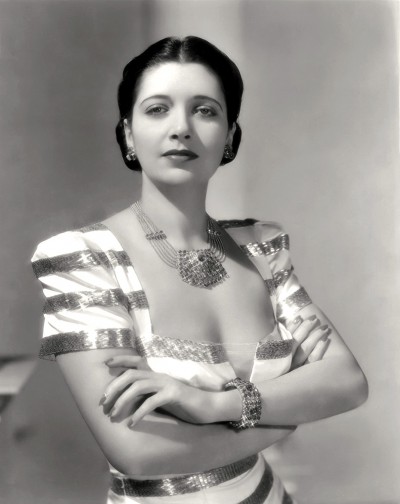Kay Francis (Kay Edwina Gibbs)

Francis was born Katharine Edwina Gibbs in Oklahoma City, Oklahoma in 1905. Her parents, Joseph Sprague Gibbs and his actress wife Katharine Clinton Francis, had been married in 1903; however, by the time their daughter was four, Joseph had left the family. Francis inherited her unusual height from her father, who stood 6′ 4″; she was to become Hollywood’s tallest leading lady (5′ 9″) in the 1930s. While she never discouraged the assumption that her mother was the pioneering American businesswoman who established the “Katharine Gibbs” chain of vocational schools, Francis was actually raised in the hardscrabble theatrical circuit of the period. In reality, her mother had been born in Nova Scotia, Canada, and eventually became a moderately successful actress and singer under the stage name Katharine Clinton.
Young Kay was often out on the road with her mother, and attended Catholic schools when it was affordable, becoming a student at the Institute of the Holy Angels at age five. After also attending Miss Fuller’s School for Young Ladies in Ossining, New York (1919) and the Cathedral School (1920), she enrolled at the Katharine Gibbs Secretarial School in New York City. At age 17, Kay became engaged to a well-to-do Pittsfield, Massachusetts man, James Dwight Francis. Their December 1922 marriage at New York’s Saint Thomas Church ended in divorce. In the spring of 1925, Francis went to Paris to get a divorce. While there, she was courted by a former Harvard athlete and member of the Boston Bar Association, Bill Gaston. Kay and Bill saw each other only on occasion; he was in Boston and Kay had decided to follow her mother’s footsteps and go on the stage in New York. She made her Broadway debut[6] as the Player Queen in a modern-dress version of Shakespeare’s Hamlet in November 1925. Francis claimed she got the part by “lying a lot, to the right people”. One of the “right” people was producer Stuart Walker, who hired Kay to join his Portmanteau Theatre Company, and she soon found herself commuting between Dayton, Indianapolis, and Cincinnati, playing wise-cracking secretaries, saucy French floozies, walk-ons, bit parts, and heavies.
By February 1927, Francis returned to Broadway in the play Crime.[8] Sylvia Sidney, although a teenager at the time, had the lead in Crime but would later say that Kay stole the show. After Kay’s divorce from Gaston, she became engaged to a society playboy, Alan Ryan Jr. She promised Alan’s family that she would not return to the stage – a promise that lasted only a few months before she was back on Broadway as an aviatrix in a Rachel Crothers play, Venus. Francis was to appear in only one other Broadway production, a play called Elmer the Great in 1928. Written by Ring Lardner and produced by George M. Cohan, Walter Huston was the star. He was so impressed by Francis that he encouraged her to take a screen test for the Paramount Pictures film Gentlemen of the Press (1929). Francis made this film and the Marx Brothers film The Cocoanuts (1929) at Paramount’s Astoria Studios in Astoria, Queens, New York.
By that time, film studios had started their exodus from New York to California, and many Broadway actors had been enticed to travel west to Hollywood to make films, including Ann Harding, Aline MacMahon, Helen Twelvetrees, Barbara Stanwyck, Humphrey Bogart and Leslie Howard. Francis, signed to a Paramount contract, also made the move, and created an immediate impression. She frequently costarred with William Powell, and appeared in as many as six to eight movies a year, making a total of 21 films between 1929 and 1931. Francis’s career flourished in spite of a slight but distinctive speech impediment (she pronounced the letters “r” and “l” as “w”) that gave rise to the nickname “Wavishing Kay Fwancis.”
Francis’ career at Paramount changed gears when Warner Brothers promised her star status at a better salary. She appeared in George Cukor’s Girls About Town (1931) and Twenty-Four Hours (1931). After Kay’s career skyrocketed at Warners, she would return to Paramount for Ernst Lubitsch’s Trouble in Paradise (1932). In 1932, Warner Brothers persuaded both Francis and Powell to join the ranks of Warners stars, along with Ruth Chatterton. In exchange, Francis was given roles that allowed her a more sympathetic screen persona than had hitherto been the case—in her first three featured roles she had played a villainess. For example, in The False Madonna (1932), she played a jaded society woman nursing a terminally ill child who learns to appreciate the importance of hearth and home. On December 16, 1931, Francis and her co-stars opened the Paramount Theatre in Oakland, California with a gala preview screening of The False Madonna.
Francis married five times. Her diaries, preserved in an academic collection at Wesleyan University, paint a picture of a woman whose personal life was often in disarray. Although considered primarily heterosexual, Francis was reported to have had a number of affairs with women and she regularly socialized with notoriously gay men, one of whom, Anderson Lawler, was reportedly paid $10,000 by Warner Brothers to accompany her to Europe in 1934. In 1966, Francis was diagnosed with breast cancer and underwent a mastectomy, but the cancer had spread and proved fatal. Having no living immediate family members, Francis left more than $1,000,000 to Seeing Eye, Inc., which trained guide dogs for the blind. She died in 1968, aged 63, and her body was immediately cremated; her ashes were scattered.
Born
- January, 13, 1905
- USA
- Oklahoma City, Oklahoma
Died
- August, 26, 1968
- USA
- New York, New York
Cause of Death
- breast cancer
Other
- Cremated



